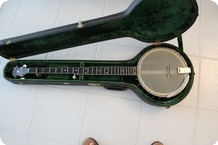Victor Banjolas / Petite Model / Stringed Instrument
5 string model designed for use with nylon strings
Aquila brand Classical Banjo 5 string nylgut strings available from Elderly Instruments and other specialty retailers
19" scale length
7/16" (11mm) string to string spacing at bridge
1 7/16" (37mm) nut width
Body wood choices: All koa
All mahogany
East Indian rosewood back and sides with western red cedar top
Binding/purfling rosette choices: Checkered rosette and purfling with wood binding
Checkered rosette with ivoroid binding (pic)
Abalone rosette and purfling with wood binding
Honduran mahogany neck with choice of Brazilian rosewood or ebony peghead veneer
Gold Grover tuners
Abalone dots on ebony fingerboard or custom abalone inlaid fingerboard
Brazilian rosewood bridge
All models come in both 5 or 6 string versions
Overall dimensions are 37" x 13 1/4" x 3 1/2".
Scale length is 25.4"
All models have high gloss lacquer finish on the body with hand rubbed semi-gloss varnish finish on the neck
Steel string models have a 2 way adjustable truss rod.
Nylon string models have a carbon fiber reinforced neck.
All models will fit any standard 5 string resonator banjo case.
All instruments come with a high quality padded gig bag.
Hardshell cases are also available.
Other features include carved fingerboard relief, all solid woods, and strap buttons upon request.
Banjola Standard Model
Banjola Classic Model
Banjola Presentation Model
Banjola Petite Model
Banjola Options And Custom Features Options and Custom Models
Strings
Steel String Models
The 5 string version comes strung - .011 .015 .022w .032w .011
The 6 string version has an extra bass string - .042w
Standard banjo strings can be used but they will tend to feel a bit lighter because the scale length (25.4") is a bit shorter than most banjos. Buy either ball end strings or put ball ends on loop end strings. Strings can be purchased individually or as guitar sets. Elixir and D'Addario both make sets in the gauges listed above called Custom Lights. If you use these you'll need to buy an additional high e string and discard the extras.
Nylon String Models
You can use any brand of classical guitar strings. My personal favorite is D'Addario Pro Arte - normal tension. If you buy sets you'll need to get an extra hi e and discard the bass E (6 string model) as well as the bass A (5 string model). If you want a slightly edgier sound on the trebles, Aquila makes very good quality 5 string sets for banjos. The Minstrel set is slightly heavier than the Classical set. If you can't find them at your local music store they can be purchased at www.elderly.com
Tunings
Five string banjolas can be tuned to any of the common 5 string banjo tunings.
The most common tuning for the 6 string banjola is in key of C: g·GCgcd
A few other interesting tunings:
Key of F: g·FCgcd
Key of G: g·GDgbd
Key of E minor: leave banjola in C tuning and capo bottom 5 strings at the 4th fret.
Holding a Banjola
The body of a banjola is much lighter than most banjos. As a result it balances differently. Some people like to use a strap, even when sitting down. Strap buttons can be installed at the butt end of the instrument and the at the side of the neck heel in the same fashion as a guitar.
A very comfortable alternative to a strap is to use a neckup support. The 2" mini version works best.
$2400.00,- / Approx. €1890.00,-
Victor Banjolas, USA 
Banjos with wooden bodies and soundboards date back at least to the 19th century. In the 1890's an instrument called a mandoline-banjo was sold by August Pollmann. Pollmann was a distributor of mostly brass instruments at the time and there is evidence to suggest that these instruments were actually built in Sweden. Check out the History Gallery for detailed photos of this instrument and the many discussed on this page.
Another name used to describe these unusual hybrid instruments was the banjo-lute. It's important to differentiate these instruments from another important instrument that is typically called a banjo mandolin.
The History Gallery
The term banjola was created by Edward Victor Dick in 1996 to describe his own version of a banjo mandola hybrid. It differed from the Pollmann instruments by having a larger body, a longer scale length, and employing a guitar style pin bridge. These innovations give his instruments greater volume and a more robust tone than the Pollmanns. The original prototype was purchased by noted songwriter and musicologist Dick Weissman.
It seems that the name "banjola" was also used as early as 1981 to describe a 4 string wooden bodied version of a tenor banjo built by Irish luthier Paul Doyle. Goldtone claims to also have independently invented the name in 2001 to describe their Asian manufactured 5 string instruments.
One of these early examples of an Victor banjola was reviewed by Ken Perlman in the Banjo Newsletter in May 1998.
In 1998 Edward built his first 6 string banjola. His intention was to expand the range of the instrument to that of the guitar (tuning gGCgcd). Examples of both this instrument as well as the 5 string version can be found on his 1999 Taptones cd. It was at this time that EVD also copywrited the name "Banjola."
In 2007 Edward redesigned both his 5 and 6 string banjolas, enlarging the bodies even further. He introduced several new models including a long neck version. In February 2008 Ken Perlman did another review of the redesigned Banjola in the Banjo Newsletter.


